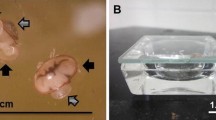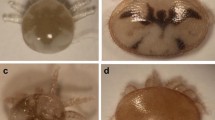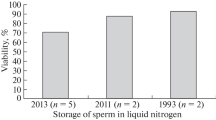Abstract
The viability of spermatozoa is a crucial parameter to appreciate semen quality and insemination potential of males both in natural mating and instrumental insemination. Here, we conducted a step-by-step investigation to address the questions why and at which step(s) the viability loss is occurring in spermatozoa of honeybees during natural mating and preparation for instrumental insemination. We detected the viability of spermatozoa in semen samples obtained from seminal vesicles and partly and fully everted endophalli of drones and in ejaculates collected into syringe tips, as well as the viability of spermatozoa in lateral oviducts of queens returning from the mating flight. A great diminish of spermatozoa viability (~10 %) was found in lateral oviducts of queens returning from mating flight (88.7 %) in comparison to viable spermatozoa in intact seminal vesicles of drones (98.1 %). Our results demonstrated that the decrease in spermatozoa viability occurs during the second stage of eversion of endophallus (viability loss, 3.3 %), and during injection of semen into the lateral oviducts of queens (viability loss, 6.1 %). The acting factor decreasing the viability of spermatozoa was the increased pressure occurring during the process of natural and instrumental insemination.










Similar content being viewed by others
References
Baer, B., Zareie, R., Paynter, E., Poland, V., Millar, A.H. (2012) Seminal fluid proteins differ in abundance between genetic lineages of honeybees. J. Proteomics 75, 5646–5653
Bieńkowska, M., Panasiuk, B., Węgrzynowicz, P., Gerula, D. (2011) The effect of different thermal conditions on drone semen quality and number of spermatozoa entering the spermatheca of queen bee. J. Apic. Sci. 55, 161–168
Burley, L.M., Fell, R.D., Saacke, R.G. (2008) Survival of honey bee (Hymenoptera. Apidae) spermatozoa incubated at room temperature from drones exposed to miticides. J. Econ. Entomol. 101, 1081–1087
Collins, A.M. (2000) Survival of honey bee (Hymenoptera: Apidae) spermatozoa stored at above-freezing temperatures. J. Econ. Entomol. 93, 421–429
Collins, A.M. (2003) A scientific note on the effect of centrifugation on pooled honey bee semen. Apidologie 34, 469–470
Collins, A.M. (2004) Sources of variation in the viability of honey bee, Apis mellifera L., semen collected for artificial insemination. Invertebr. Reprod. Dev. 45, 231–237
Collins, A.M., Donoghue, A.M. (1999) Viability assessment of honey bee, Apis mellifera, sperm using dual florescent staining. Theriogenology 51, 1513–1523
Collins, A.M., Pettis, J.S. (2001) Effect of varroa infestation on semen quality. Am. Bee J. 141, 590–593
Czekońska, K., Chuda-Mickiewicz, B., Chorbiński, P. (2013a) The effect of brood incubation temperature on the reproductive value of honey bee (Apis mellifera) drones. J. Apic. Res. 52, 96–105
Czekońska, K., Chuda-Mickiewicz, B., Chorbiński, P. (2013b) The influence of honey bee (Apis mellifera) drone age on volume of semen and viability of spermatozoa. J. Apic. Sci. 57, 61–66
Dade, H. A. (1977) Anatomy and dissection of the honeybee. International Bee Research Association; London.
den Boer, S.P.A., Boomsma, J.J., Baer, B. (2009) Honey bee males and queens use glandular secretions to enhance sperm viability before and after storage. J. Insect Physiol. 55, 538–543
Gençer, H.V., Kahya, Y. (2011a) Are sperm traits of drones (Apis mellifera L.) from laying worker colonies noteworthy? J. Apic. Res. 50, 130–137
Gençer, H.V., Kahya, Y. (2011b) The viability of sperm in lateral oviducts and spermathecae of instrumentally inseminated and naturally mated honey bee (Apis mellifera L.) queens. J. Apic. Res. 50, 190–194
Holman, L. (2009) Sperm viability staining in ecology and evolution: potential pitfalls. Behav. Ecol. and Sociobiol. 63, 1679–1688
Hopkins, B.K., Herr, C. (2010) Factors affecting the successful cryopreservation of honey bee (Apis mellifera) spermatozoa. Apidologie 41, 548–556
Hunter, F.M., Birkhead, T.R. (2002) Sperm viability and sperm competition in insects. Curr. Biol. 12, 121–123
Imhoof, M. (2012) More than honey. Film Against Gravity
Koeniger, G. (1986) Mating sign and multiple mating in the honeybee. Bee World 67, 141–150
Koeniger, G. (n.d.) Mehrfachpaarung der Bienenkönigin. Ein Film des Institut für Bienenkunde, Oberursel, Germany.
Koeniger, N., Koeniger, G. (1991) An evolutionary approach to mating behavior and drone copulatory organs in Apis. Apidologie 22, 581–590
Koeniger, G., Koeniger, N., Fabritius, M. (1979) Some detailed observations of mating in the honey bee. Bee World 60, 53–57
Laidlaw Jr., H.H., Page Jr., R.E. (1997) Queen rearing and bee breeding. Wicwas Press, Cheshire
Locke, S.J., Peng, Y.S. (1993) The effects of drone age, semen storage, and contamination on semen quality in the honey bee (Apis mellifera). Physiol. Entomol. 18, 144–148
Lodesani, M., Balduzzi, D., Galli, A. (2004) Functional characterization of semen in honeybee queen (A. m. ligustica S.) spermatheca and the efficiency of diluted semen technique in instrumental insemination. Ital. J. of Anim Sci. 3, 385–392
Moritz, R.F.A. (1984) The effect of different diluents on insemination success in the honeybee using mixed semen. J. Apic. Res. 23, 164–167
Page Jr., R.E. (1986) Sperm utilization in social insects. Annu. Rev. Entomol. 31, 297–320
Paynter, E., Baer-Imhoof, B., Linden, M., Lee-Pullen, T., Heel, K., Rigby, P., Baer, B. (2014) Flow cytometry as a rapid and reliable method to quantify sperm viability in the honeybee Apis mellifera. Cytometry Part A . 85, 463–472
Peer, D.F. (1956) Multiple mating of queen honey bees. J. Econ. Entomol. 49, 741–743
Ruttner, F. (1988) Breeding techniques and selection for breeding of the honeybee. British Isles of Bee Breeders’ Association, Derby
Ruttner, F., Koeniger, G. (1971) Die Füllung der Spermatheca der Bienenkönigin. Aktive Wandering oder Passiver Transport der Spermatozoen? Z. Vergl Physiolgie 72, 411–422
Rzymski, P., Langowska, A., Fliszkiewicz, M., Poniedziałek, B., Karczewski, J., Wiktorowicz, K. (2012) Flow cytometry as an estimation tool for honey bee sperm viability. Theriogenology 77, 1642–1647
Schlüns, H., Koeniger, G., Koeniger, N., Moritz, R.F.A. (2004) Sperm utilization pattern in the honeybee (Apis mellifera). Behav. Ecol. Sociobiol. 56, 458–463
Stürup, M., Baer-Imhoof, B., Nash, D.R., Boomsma, J.J., Baer, B. (2013) When every sperm counts: factors affecting male fertility in the honeybee Apis mellifera. Behav. Ecol. 24, 1192–1198
Taber, S. (1954) The frequency of multiple mating of queen honey bees. J. Econ. Entomol. 47, 995–998
Tofilski, A., Chuda-Mickiewicz, B., Czekońska, K., Chorbiński, P. (2012) Flow cytometry evidence about sperm competition in honey bee (Apis mellifera). Apidologie 43, 63–70
Verma, L.R. (1974) Honeybee spermatozoa and their survival in the queen’s spermatheca. Bee World 55, 53–61
Wegener, J., Bienefeld, K. (2012) Toxicity of cryoprotectants to honey bee semen and queens. Theriogenology 77, 600–607
Wegener, J., May, T., Knollmann, U., Kamp, G., Müller, K., Bienefeld, K. (2012) In vivo validation of in vitro quality tests for cryopreserved honey bee semen. Cryobiol. 65, 126–131
Woyke, J. (1956) Anatomo-physiological changes in queen bees returning from mating flights, and the process of multiple mating. Bull. Acad. Polon. Sci 4, 81–87. online; jerzy_woyke.users.sggw.pl/1956_anphymat.pdf
Woyke, J. (1962) Natural and artificial insemination of queen honeybees. Bee World 43, 21–25
Woyke, J. (1983) Dynamics of entry of spermatozoa into the spermatheca of instrumentally inseminated queen honeybees. J. Apic. Res. 22, 150–154
Woyke, J. (1988) A mathematical model for the dynamics of spermatozoa entry into the spermathecae of instrumentally inseminated queen honeybees. J. Apic. Res. 27, 122–125
Woyke, J. (2008) Why the eversion of endophallus of honey bee drone stops at the partly everted stage and significance of this. Apidologie 39, 627–636
Woyke, J. (2010) Three substances ejected by Apis mellifera drones during endophallus eversion as well as during natural matings with queen bees. Apidologie 41, 613–621
Woyke, J. (2011) The mating sign of queen bees originates from two drones and the process of multiple mating in honey bees. J. Apic. Res. 50, 272–283
Acknowledgments
We thank two anonymous reviewers for their constructive comments and suggestions. We also thank Siamak Hamednia and Burak Kiziltepe for their help with field and laboratory work.
Author information
Authors and Affiliations
Corresponding author
Additional information
Manuscript editor: James Nieh
Pourquoi la viabilité des spermatozoïdes diminue chez l’abeille, Apis mellifera , très rapidement après un acccouplement ou après la préparation pour une insémination artificielle
Mâle / reine / éversion de l’endophallus / insémination artificielle / spermatozoïdes
Warum die Lebensfähigkeit der Spermatozoen von Honigbienen ( Apis mellifera ) innerhalb kurzer Zeit während der natürlichen Begattung und der Präparation für die künstliche Besamung abnimmt
Drohn / Königin / Ausstülpen des Endophallus / künstliche Besamung / Sparmatozoenlebensfähigkeit
Rights and permissions
About this article
Cite this article
Gençer, H.V., Kahya, Y. & Woyke, J. Why the viability of spermatozoa diminishes in the honeybee (Apis mellifera) within short time during natural mating and preparation for instrumental insemination. Apidologie 45, 757–770 (2014). https://doi.org/10.1007/s13592-014-0295-0
Received:
Revised:
Accepted:
Published:
Issue Date:
DOI: https://doi.org/10.1007/s13592-014-0295-0




